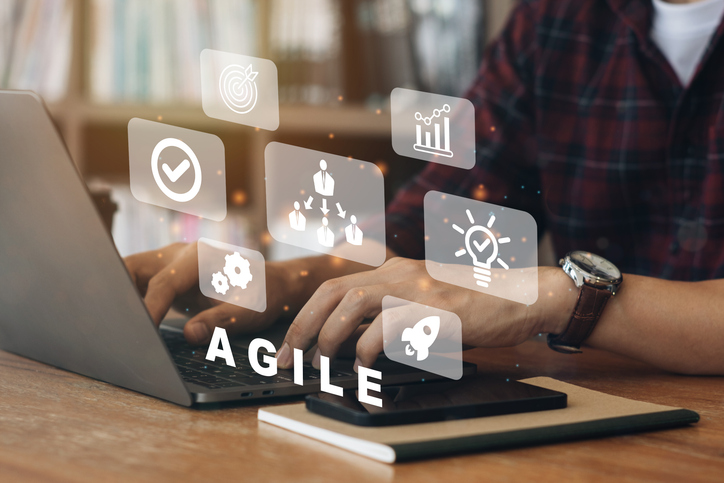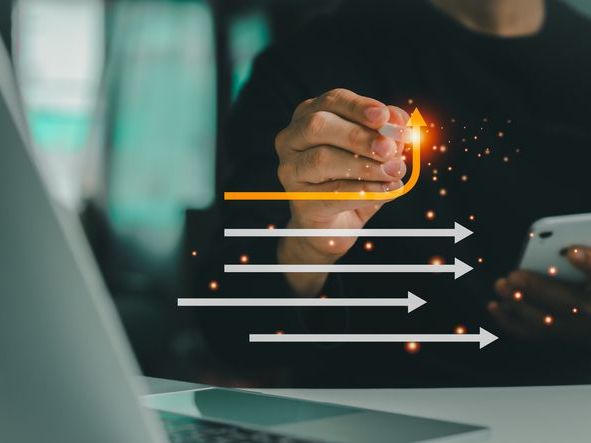
AI in HR: How to Use Technology to Improve Efficiency, Engagement & Retention
October 28, 2025 Written by Rafael Spuldar

Compare Providers
Download our outplacement comparison sheet
Request Pricing
Compare our rates to other providers
If you’re familiar with today’s labor market and workplace trends, you already know the challenges HR leaders are facing: difficulty sourcing the best talent, rising global skills gaps, evolving employee expectations, etc. What’s more, AI is rapidly disrupting work processes, making HR’s role in managing change even more difficult.
Given its promise to upend the business landscape across industries, AI must be a central part of HR strategic initiatives just as it is in other departments, such as IT or marketing. But how exactly is AI changing HR?
In this article, we’ll examine the impact of AI in HR, its main benefits and most pressing concerns, and three key aspects of HR being transformed by this new technology: employee recruiting, career frameworks, and performance management.
What Is the Meaning of AI in HR?
Leveraging artificial intelligence (AI) in HR involves applying AI-based technologies to automate and transform traditional HR processes and strategies. HR teams can use AI-powered platforms to analyze vast datasets, generate data-driven insights, automate repetitive tasks, improve the employee experience, and support decision-making across the organization.
Here are some of the results HR can achieve through AI:
- Enhance talent search and candidate sourcing
- Streamline onboarding and HR workflows
- Personalize training and learning paths
- Analyze and visualize performance data
- Predict and prevent employee turnover
- Monitor and improve employee engagement
- Support data-driven workforce planning
What Are the Benefits of AI in HR?
AI is reshaping HR functions by enabling smarter, faster, and more data-driven work, thereby enhancing overall productivity, engagement, and organizational performance. Let’s look into the main benefits AI-powered solutions are bringing to HR teams in most organizations.
Smarter, Data-Driven Decisions
AI transforms large volumes of HR data into actionable insights, enabling predictive decision-making on turnover, skills gaps, and performance trends that traditional analysis might overlook or take weeks to uncover.
Through dashboards and benchmarking tools, HR can identify emerging challenges faster, ensuring that leadership decisions are guided by real-time evidence rather than assumptions or subjective interpretation alone.
Streamlined Operations
AI automates repetitive tasks like scheduling, data entry, and reporting, saving HR teams valuable time while minimizing human error and ensuring greater consistency across daily workforce management activities.
By handling routine processes efficiently, AI enables HR professionals to focus on meaningful initiatives—like culture building, employee engagement, and strategic workforce planning—that directly influence organizational success and satisfaction.
Cost Efficiency
AI drives down operational costs by streamlining hiring, onboarding, and training processes, allowing HR budgets to be invested in leadership development and other long-term strategic initiatives that drive growth.
By reducing inefficiencies and improving accuracy, organizations experience measurable savings and higher productivity—turning AI into both an operational advantage and a key contributor to business sustainability.
STATISTICAL INSIGHT:
A 2025 study by the Wharton School of the University of Pennsylvania indicates that the average labor cost savings from organizations adopting current AI tools is presently at 25%, with the potential for that to increase to 40% over the coming decades.
Organizational Agility
AI gives HR teams the agility to adapt quickly to workforce shifts, using data insights to anticipate talent needs and respond swiftly to organizational changes or emerging skill demands.
This agility supports stronger retention, better decision-making, and more responsive workforce planning. Ultimately, companies leveraging AI can innovate faster while maintaining an engaged, high-performing workforce.
If you’re looking for more guidance on navigating your organization’s workforce planning process from start to finish, click below to download our free, comprehensive Careerminds workforce planning guide.
What Are the Disadvantages of AI in HR?
While AI delivers immense benefits, its adoption also raises ethical, technical, and human concerns. From protecting privacy to maintaining empathic connections, HR must ensure that AI is used responsibly and transparently. Here are some key challenges around using AI in HR.
Diminished Human Connection
While AI enhances efficiency, overreliance risks removing empathy from HR processes that depend on trust, understanding, and emotional intelligence, like career coaching, recognition, and sensitive employee conversations.
Balancing automation with human touch is vital. HR should use AI as an assistant to strengthen—not replace—authentic interactions that build lasting employee relationships and organizational culture.
Data Privacy and Security Risks
AI systems rely heavily on personal and behavioral data, raising concerns about privacy, consent, and potential misuse if not governed by transparent, compliant security frameworks within HR operations.
To mitigate risks, HR must enforce strict data protection policies, maintain clear communication about data usage, and regularly audit systems to ensure confidentiality and employee trust.
STATISTICAL INSIGHT:
According to a 2025 McKinsey study with 3,000 US employees across industries, these were the top concerns associated with generative AI in the workplace:
Cybersecurity: 51% of respondents
Inaccuracy: 50%
Personal privacy: 41%
Intellectual property infringement: 40%
Skewed Ethics and Bias
AI can unintentionally reinforce bias if trained on non-diverse datasets, leading to unequal outcomes in hiring, performance evaluation, or promotions—thereby undermining inclusion efforts and employee confidence.
To ensure fairness, HR should partner with data experts to monitor algorithmic outputs, refine models, and verify that decisions reflect diversity, equity, and unbiased representation across the workforce.
Employee Resistance
Employees may view AI adoption as threatening or impersonal, especially if they fear job loss or constant performance monitoring through automated systems or analytics tools.
Transparent communication, ongoing training, and inclusion in AI implementation processes build understanding and trust, showing employees that AI enhances collaboration and opportunity rather than replacing human contribution.
How AI Is Transforming 3 Key Elements in HR
Now that we’ve reviewed the key benefits and challenges, the next question is: How are people using AI in HR? Increasingly, HR teams are implementing AI solutions across the entire employee lifecycle, in many different scenarios and with various results.
Now, we’ll look more closely at three common HR processes to which AI is bringing transformational results.
1. Recruiting
AI simplifies recruitment by automating sourcing, screening, and scheduling tasks that once consumed hours of manual work. It helps identify qualified candidates faster, reduces bias in decision-making, and allows recruiters to focus on building meaningful connections with applicants rather than repetitive administrative duties.
With predictive analytics and natural language processing, AI systems can also assess candidate suitability based on skills, experience, and behavioral cues. This creates fairer, data-driven hiring decisions while improving candidate experience through speed, personalization, and transparency.
Examples:
- An AI platform automatically scans job boards and ranks top candidates based on skill match and cultural fit.
- Chatbots handle initial applicant questions and schedule interviews within minutes.
- Automated writing assistants generate job postings that appeal to diverse audiences.
2. Career Frameworks
Modern career frameworks make professional growth transparent and intuitive for every employee. By replacing static spreadsheets with dynamic, visual platforms, HR teams can clearly map skills, roles, and levels—giving employees the structure and clarity they need to chart meaningful career paths across the organization.
These frameworks improve engagement by empowering people to take ownership of their development. When employees understand what’s required for advancement, they feel supported and motivated to grow internally rather than seek opportunities elsewhere. This visibility not only boosts confidence but also strengthens long-term talent retention.
Examples:
- An employee logs into a platform that visually shows how to progress from a coordinator to a senior specialist, complete with required skills and competencies.
- HR managers use built-in templates to update job levels and skills within minutes, keeping frameworks current and accurate.
- A new hire explores interactive pathways, selecting future roles that align with their interests—reinforcing commitment and loyalty from day one.
If you need help setting up career frameworks, click below to learn about our AI-powered solutions. With Careerminds, you’ll build your frameworks in minutes, saving your HR team weeks and giving your staff customized career paths that keep them engaged and growing.
3. Performance Management
AI transforms performance management into a continuous, dynamic process. Real-time data analysis provides managers with insights into productivity, engagement, and collaboration trends, helping them coach employees effectively and recognize achievements as they happen—not just during their annual reviews.
AI tools can also detect performance dips early and recommend targeted interventions such as mentoring or training. By replacing intuition with data-backed insights, leaders can make more objective decisions while supporting personalized growth and accountability across teams.
Examples:
- A dashboard highlights team members who consistently exceed project deadlines.
- Algorithms flag communication bottlenecks or uneven workloads within teams.
- An AI assistant suggests recognition messages or coaching topics based on feedback patterns.
AI in HR FAQ
Here are some frequently asked questions about AI in HR and the workplace.
What Jobs Won’t Be Replaced by AI?
Roles that require emotional intelligence, critical thinking, and creativity will certainly remain human jobs. Leadership, coaching, relationship management, and problem-solving all depend on empathy and nuance that AI can’t replicate.
These functions rely on trust, adaptability, and thoughtful judgment—qualities that are central to organizational success. So humans will remain at the heart of work for these jobs.
Is HR Being Replaced by AI?
In a word, no. AI is transforming HR, but not replacing it. When HR professionals use AI to automate repetitive tasks like scheduling or data entry, it frees their time to focus on strategy, culture, and employee experience.
The human element—represented by empathy and connection—remains irreplaceable, so HR will continue to play a vital, people-centered role within organizations.
Will Payroll Be Replaced by AI?
Similarly, AI will streamline payroll, not eliminate it. Automated systems already handle calculations, compliance checks, and reporting faster than ever, but HR oversight remains essential.
Human professionals interpret complex regulations, resolve exceptions, and ensure fairness. Together, AI efficiency and human judgment create a payroll process that’s both accurate and intelligent.
Which AI Tool Is Best for HR?
The best AI tool depends on your goals. For recruiting, tools that automate sourcing and screening are invaluable. For engagement or performance, platforms with predictive analytics and personalized feedback work best.
However, the most effective AI tools are built for simplicity, transparency, and real impact. Look for user-friendly, insight-driven platforms that can drive adoption, increase visibility, and strengthen engagement across the board.
AI in HR: Final Thoughts
AI is reshaping HR into a smarter, faster, and more people-focused function. By automating repetitive tasks and uncovering data-driven insights, HR teams can focus on what truly matters—strategic workforce planning, talent development, and meaningful employee connections.
However, the numbers show that there’s still room for improvement in how organizations make the best of this new technology and its transformative power.
STATISTICAL INSIGHT:
According to the same 2025 McKinsey study, only 1% of C-suite executives perceive that their organizations are rolling out “fully mature” AI strategies—in other words, fully utilizing generative AI to change how work is done and drive relevant business outcomes.
This presents an opportunity for HR to step up and lead the way to AI adoption. HR leaders can use their own results as a benchmark to make the case for a speedier AI rollout and prove its strategic value. Meanwhile, HR can keep leveraging AI to boost talent retention and employee engagement, creating a virtuous cycle where technology and empathy work hand in hand.
To learn more about Careerminds’ modern, AI-powered approach to career frameworks and talent development, click below to speak with our experts and book a demo today. We might be just the partner you need to transform your HR processes and empower your workforce to drive the results you want.
In need of outplacement assistance?
At Careerminds, we care about people first. That’s why we offer personalized talent management solutions for every level at lower costs, globally.





